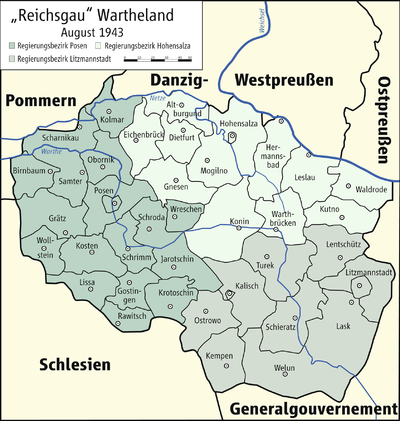District of Hohensalza

During the Second World War, the Hohensalza district was the name of a German administrative unit in occupied Poland (1939–45) .
Prehistory (1815 to 1920)
The area around the western Polish city of Inowrocław belonged from 1815 to 1919 as the Inowrazlaw district (after 1904 the Hohensalza district ) to the Prussian province of Posen . In the course of the Wielkopolska Uprising , Inowrocław came under Polish control in January 1919 and was officially ceded to the newly founded Poland on June 28, 1919 with the signing of the Versailles Treaty . The area around the city of Argenau, which remained under German control, was cleared and handed over to Poland between January 17 and February 4, 1920.
Administrative history
At the beginning of World War II , German troops occupied the western Polish powiat Inowrocław , and the district town of Inowrocław was captured on September 8, 1939.
On October 26, 1939, the powiat was annexed to the German Reich under the name Landkreis Hohensalza , which as a unilateral act of violence was ineffective under international law. The district became part of the administrative district Hohensalza in the Reichsgau Wartheland .
The seat of the German district office (and the district president of the administrative district) was the district town of Inowrocław , which, however, did not belong to the district, but formed its own urban district .
The German occupation ended with the invasion of the Red Army in January 1945.
politics
Land Commissioner
- 1939 : Walter Hammersen (1911–1990)
District administrators
- 1939–1942: Walter Hammersen
- 1942–1945:?
Municipal structure
The localities of the district were initially grouped into 10 administrative districts . On April 1, 1943, the district of Wikingen-Stadt was named a city according to the German municipal code of 1935. Towards the end of the occupation, the district consisted of 1 city ( Kruschwitz ) and 9 administrative districts.
population
The district of Hohensalza had in 1941: 67,161 mostly Polish inhabitants. Between December 1, 1939 and December 31, 1943, the German occupation authorities expelled over 9700 Poles from the area.
A small German minority lived in the area (1926: 8,455 people or 11.5% of the urban and district population), while Germans were also settled during the occupation. Towards the end of the occupation, most of them left the area.
The Jewish population was deported to the General Government and murdered there.
Place names
The local occupation authorities gave all localities in the district with German names, although officially according to the unpublished decree of the Interior Minister of December 29, 1939, the German names valid from 1918 should initially continue to apply. On May 18, 1943, German names were set for all places with a post or train station in Wartheland , although there were again deviations.
List of cities and administrative districts in the Hohensalza district:
| Polish name | German name (1918) | German name (1939-1945) |
|---|---|---|
| Chełmce | Chelmce | Grünholm |
| Dąbrowa Biskupia | Louisenfelde | Luisenfelde |
| Gniewkowo | Argenau | Argenau |
| Inowrocław | Hohensalza | Hohensalza |
| Kruszwica | Kruschwitz |
1939–1943 Wikingen 1943–1945 Kruschwitz |
| Rojewo | Roneck |
1939-1943 Roneck 1943-1945 Rooneck |
| Zlotniki Kujawskie | Güldenhof | Güldenhof |
Personalities
- Walter Hammersen ( district administrator and NSDAP district leader of the Hohensalza district , later FDP )
literature
- Gustav Neumann : Geography of the Prussian State . 2nd edition, Volume 2, Berlin 1874, pp. 160-161, item 6.
- Royal Statistical Bureau: The municipalities and manor districts of the Prussian state and their population. Edited and compiled from the original materials of the general census of December 1, 1871. Part IV: The Province of Posen , Berlin 1874, pp. 188–203 ( e-copy, pp. 195-210 ).
- Leopold von Zedlitz-Neukirch : The Prussian state in all its relations . Volume 3, Berlin 1837, p. 172, point 5.
- M. Rademacher: German administrative history from the unification of the empire in 1871 to the reunification in 1990. (online material for the dissertation, Osnabrück 2006)
Web links
- District of Hohensalza Administrative history and the district administrators on the website territorial.de (Rolf Jehke), as of August 18, 2013.